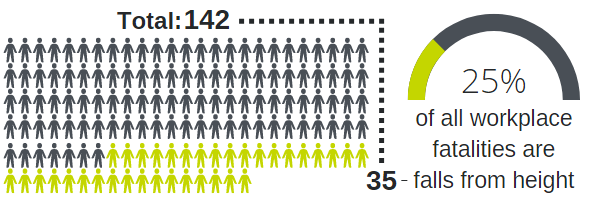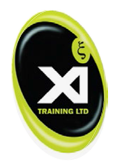Falls from Height - the UK's Biggest Workplace Killer

Out of a total of 142 worker fatalities in the UK in 2020/21, 35 were a direct result of a fall from height.
Many accidents are preventable, making sure you have the correct procedures and workplace training in place is essential; how can you make sure that these risks stay minimal? And how can you best protect your colleagues? Below is a list of some best practices to take into account:
Prevention is better than a cure...
One of the most important procedures that you can and should be practicing is risk assessment, noting any potential hazards before any of your colleagues attend a worksite is of paramount importance. Having control measures in place will greatly reduce the risk of a potential injury and very well could just save someones life.
Correct Training...
You wouldn't expect someone to be able to fly a plane without having been trained, the same applies in every workplace in relation to a workers duties.
A worker unaware of the dangers becomes a danger, not only to themselves but also those they are working alongside; professional training is one of the easiest ways to ensure your colleagues attain knowledge and skills on how to remain safe and operate under best practice.
We offer a free consultation service if you have any concerns or are unsure about what training you and your colleagues may require.
A worker is only as good as their tools...
PPE is not only essential, it is required by Law.
As an employer, you are obliged to provide your colleagues with the correct equipment for the job at hand. However, just providing the PPE is often not enough, ensuring that your colleagues have been trained on how to properly operate, maintain and safely use the equipment is also imperative. Important topics such as pre-use inspections and buddy checks should be included.
Dos and dont's of working at height, excerpt from the HSE website:
- Do….
- as much work as possible from the ground
- ensure workers can get safely to and from where they work at height
- ensure equipment is suitable, stable and strong enough for the job, maintained and checked regularly
- take precautions when working on or near fragile surfaces
- provide protection from falling objects
- consider emergency evacuation and rescue procedures
- Don't…
- overload ladders – consider the equipment or materials workers are carrying before working at height. Check the pictogram or label on the ladder for information
- overreach on ladders or stepladders
- rest a ladder against weak upper surfaces, eg glazing or plastic gutters
- use ladders or stepladders for strenuous or heavy tasks, only use them for light work of short duration (a maximum of 30 minutes at a time)
- let anyone who is not competent (who doesn't have the skills, knowledge and experience to do the job) work at height
Contact our expert team using the details below if you have any concerns or wish to discuss what training or PPE you may need for your line of work:
This email address is being protected from spambots. You need JavaScript enabled to view it.
01524 736 510
We gathered the information above via the HSE website, links provided below if you wish to read more:
Work-related fatal injuries in Great Britain
Relevant courses:
MATS / EUSR Basic Tower Climber & Rescue Initial Validation
MATS / EUSR Basic Tower Climber & Rescue Re-validation
Warehouse Racking Access & Rescue
News Release Ends


